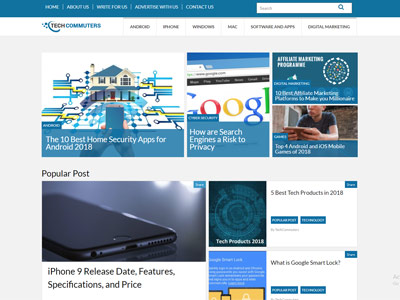Enhance Your Knowledge with the Best tech blog Including Industry Experts
Recognizing the Increase of Side Computing in Today's Digital World
In the swiftly evolving landscape of innovation, edge computer becomes a pivotal pressure, reshaping how data is processed and utilized. This paradigm change is driven by the spreading of IoT devices and an intensifying demand for rapid data handling. By transitioning information management closer to the resource, side computing addresses essential latency problems while optimizing data transfer use and improving safety procedures. As industries pivot in the direction of smarter, more efficient systems, recognizing the subtleties and effects of this technological innovation comes to be critical. What does this mean for future developments and the digital community all at once?
What Is Side Computer
Side computer, although a reasonably recent innovation in the world of modern technology, essentially changes just how data is processed and managed by bringing computation and information storage space closer to the area where it is required. Unlike traditional cloud computer designs, which usually depend on central data centers that can be geographically remote, edge computer decentralizes information handling. This distance lowers latency, boosts real-time information handling, and boosts the total user experience by making sure much faster reaction times.
At its core, side computer involves a network of local tools and framework, such as routers, sensors, and portals, with the ability of refining information at or near the source. This local handling capability is especially crucial for applications requiring instant information analysis, such as autonomous cars, commercial automation, and smart cities. In addition, by unloading information processing jobs from main servers, side computing decreases bandwidth needs and improves data privacy and protection, as sensitive information can stay on-site instead of traversing substantial networks.

Secret Vehicle Drivers of Fostering
Several aspects are thrusting the fostering of edge computer in today's digital landscape. Among the key chauffeurs is the exponential rise in connected gadgets, often referred to as the Net of Points (IoT) This rise develops vast quantities of information that require to be refined quickly and efficiently. Edge computing addresses this requirement by allowing information processing closer to the data resource, minimizing latency and boosting real-time decision-making capacities.
Another substantial chauffeur is the need for boosted bandwidth effectiveness. Centralized cloud systems can come to be overloaded with the sheer volume of information generated by IoT tools, bring about bottlenecks (Best tech blog). By refining information at the edge, companies can alleviate network congestion and improve general system efficiency
Moreover, safety and security and privacy issues are pressing organizations towards side computer. By refining sensitive information locally, companies can minimize dangers linked with data transmission and exposure to prospective cyber threats.
The rise of applications needing real-time processing, such as self-governing vehicles and increased truth, also requires the rapid reaction times that border calculating offers. Collectively, these motorists are making side calculating a vital part of modern IT facilities, leading the way for its prevalent fostering throughout different markets.
Advantages Over Cloud Computer
Just how does edge computer distinguish itself from typical cloud computer? Mainly, edge computing brings information processing closer to the source of information generation, typically on nearby web servers or neighborhood tools, rather than relying upon central information facilities. This proximity dramatically lowers latency, allowing real-time data handling and decision-making. For markets where milliseconds matter, such as autonomous automobiles or commercial automation, the lowered latency offered by edge computer can be essential.
Furthermore, side computer boosts transmission capacity effectiveness (Best tech blog). By processing information locally, only the needed information is transferred to the cloud for additional analysis or storage, minimizing Recommended Site the volume of data that passes through the network. This not only reduces network congestion but additionally decreases information transmission expenses
Edge computing additionally uses improved information personal privacy and safety and security. Sensitive information can be refined locally without being sent out to the cloud, decreasing the exposure to possible cyber hazards. This is specifically useful for fields managing private information, such as healthcare and monetary services.
Furthermore, side computing ensures better resilience and reliability. Neighborhood handling enables continued procedure also when connection to the cloud is endangered, preserving crucial features and solutions despite potential network disruptions. These advantages collectively show side computing's transformative potential in enhancing performance and safety and security in electronic communities.
Factors To Consider and challenges
While side computer uses many advantages, it likewise provides unique difficulties and factors to consider that need to be addressed to fully recognize its possibility. One significant difficulty is data safety and privacy. Handling data better to the source increases the threat of unapproved accessibility, demanding robust security and rigid protection procedures to protect delicate information. In addition, handling and checking a decentralized network of edge tools can be complicated, calling for sophisticated tools and methods to make certain seamless operation and maintenance.
One more factor to consider is the scalability of side computing options. As the variety of connected tools expands, so does the need for refining power at the edge, which can bring about source restraints. Organizations has to meticulously plan their framework to fit this growth without jeopardizing performance or effectiveness.
Interoperability is another critical factor. With different software and hardware elements involved, ensuring compatibility and smooth assimilation can be challenging. Standardization efforts are necessary to facilitate interaction in between disparate systems.
Future Fads in Edge Computing
Anticipating the future, side computer is positioned to revolutionize various industries by allowing quicker data handling and decreasing latency. As the quantity of data created by IoT devices proceeds to grow, edge computer will certainly become significantly important in managing this increase effectively. One significant trend is the integration of fabricated knowledge at the side, enabling real-time analytics and decision-making without counting on cloud-based sources. This change is prepared for to improve applications in autonomous vehicles, wise cities, and medical care, where immediate data processing is critical.
One more arising pattern is the development of edge-native applications made specifically to utilize the one-of-a-kind abilities of side computer. These applications will certainly optimize efficiency and resource application, causing boosted Read More Here performance across numerous industries. Additionally, advancements in 5G technology will certainly better bolster edge computer by supplying the needed infrastructure for high-speed, low-latency communication in between tools and side nodes.
Conclusion
Side computing's surge is driven by the spreading of IoT tools and the need for real-time data handling, which boosts efficiency by lowering latency and decentralizing data management. This method alleviates data transfer ineffectiveness and safety problems, promoting developments in applications like smart cities and autonomous lorries. Despite site link difficulties such as framework intricacy and assimilation, the future of side computing promises an extra receptive electronic ecological community, with continued advancements forming its evolution and expanding its applicability across sectors.
Side computer, although a relatively current innovation in the world of innovation, basically changes exactly how information is refined and handled by bringing calculation and data storage space closer to the location where it is needed. Unlike conventional cloud computing versions, which usually depend on centralized data facilities that can be geographically far-off, edge computer decentralizes data handling. In addition, by offloading data processing jobs from main web servers, side computer reduces data transfer requirements and improves data privacy and protection, as sensitive information can remain on-site instead than going across considerable networks.
